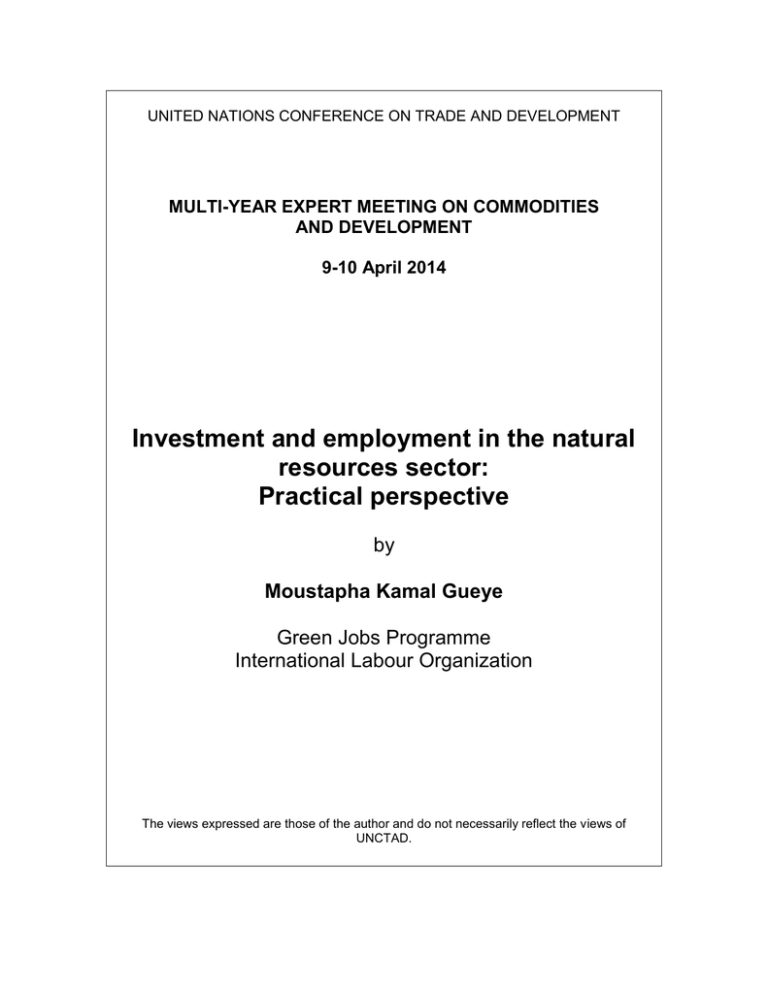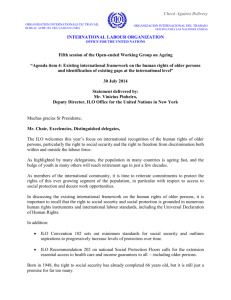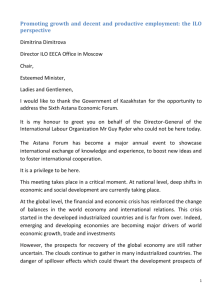Investment and employment in the natural resources sector: Practical perspective
advertisement

UNITED NATIONS CONFERENCE ON TRADE AND DEVELOPMENT MULTI-YEAR EXPERT MEETING ON COMMODITIES AND DEVELOPMENT 9-10 April 2014 Investment and employment in the natural resources sector: Practical perspective by Moustapha Kamal Gueye Green Jobs Programme International Labour Organization The views expressed are those of the author and do not necessarily reflect the views of UNCTAD. Investment and employment in the natural resources sector: practical perspective Moustapha Kamal Gueye Green Jobs Programme International Labour Organization Global employment trends • 202 million people unemployed in 2013 - 5 million more than in 2012. • Global unemployment set to worsen - over 215 M. jobseekers by 2018. • Youth unemployment rate at 13.1% (74.5 million) is almost three times as high as the adult unemployment rate – reaching a historical peak. • SSA total unemployment: 7.8%; higher in North Africa, particularly for youth. • Vulnerable employment in SSA: 77.4% - the highest of all regions (world average 48%). • Working poverty declining slower than in previous decades: 839 million workers (26.7% of total employment) living on less than US$2 a day. Source: ILO: Global Employment Trends 2014 Resource-intensive industries and employment • Despite significant levels of investment, resource and energy-intensive industries have a modest share of total global employment. • Employment has been declining in industries such as mining, fossil fuelbased energy or iron and steel as a result of increased automation and rising labour productivity. • E.g. some 70,000 South African power sector jobs were lost between 1980 and 2000, despite an increase in electricity generation by more than 60%. Global employment in resource-intensive sectors Risks to productivity and jobs The resource-intensive development model will lead to rising costs, loss of productivity and disruption of economic activity: In a BAU scenario (ILO Global Economic Linkages model) • Productivity level drop 2.4% by 2030; 7.2% by 2050. In contrast In a Green Economy (ILO Global Economic Linkages model) • 0.5-2% Net job gains = this translates in 15-60 million additional jobs • Multi-factor productivity can improve by 1.5% by 2020; 5% by 2050. 8 key sectors: agriculture, forestry, fishing, energy, resource-intensive manufacturing, recycling, building and transport. Source: ILO 2012, Working towards sustainable development. Opportunities for decent work and social inclusion in a green economy Investments in forests and employment creation • Over 2 million jobs based on certified sustainable forest management. • Funding of US$30 billion from REDD+ and other payments for ecosystem services would deliver 8 million jobs in poor regions of developing countries Source: ILO 2012, Working towards sustainable development. Opportunities for decent work and social inclusion in a green economy Growing investments in renewable energies $244 billion of investment in renewable power and fuels (including small hydro-electric projects) in 2012. GLOBAL NEW INVESTMENT IN RENEWABLE ENERGY BY ASSET CLASS, 2004-2012, $BN Renewable energies and jobs • Over 5.7 million people were employed directly or indirectly in the renewable energy industry in 2012 – a figure that could triple by 2030. • The largest number of jobs is found in biofuels and solar photovoltaic, 1.38 million and 1.36 million, respectively. Source: IRENA, 2013, Renewable Energy and Jobs. Note: excl large hydropower and traditional biomass Employment-intensive green investments and conditional cash transfers The Mahatma Gandhi National Rural Employment Guarantee Act of India is one example of programmes providing direct income transfers through public works. • Right to 100 paid working days/year • Work in climate change adaptation, afforestation, water conservation/harvesting • 50 million persons participated in 2010-2011 The Bolsa Verde programme in Brazil • The Brazilian Bolsa Verde (green grant) programme includes a green grant designed to provide incentives to poor families living in natural reserve areas to engage in environmental conservation. Colombia and Mexico have implemented similar programmes. • In its first year Bolsa Verde provided monthly payments of about US$35 each to about 16,634 poor families in protected public areas as compensation for the environmental service of preserving these areas. • There are plans to extend the coverage to 300,000 families, encompassing a broader range of measures, such as clean energy use. Expanded public works programme in South Africa • The EPWP Phase (2004-2009) created 1 million work opportunities • Phase 2 (2009-2014) set an ambitious 4,5 million work opportunities target. The Working for Water programme is estimated to have saved as much as R400 billion (CSIR), cleared over 2 million ha of alien invasive plants, and prevented the loss of 71% of grazing. Working on Fire in 2007/2008 saved the forestry industry alone R3,7 billion – on a budget of R123 million. Source: Department of Public Works, South Africa Young entrepreneurs turning waste into wealth Business Skills Challenges to young entrepreneurs Finance Youth Technical skills 11,000 new businesses; 23,000 new jobs by 2014. In 2010-2012 4,680 students participated in green entrepreneurship program of Junior Achievement (world’s largest youth business network) In a 2011 competition, 31 Student companies (43%) out of 73 created green businesses. Green investments can have higher employment multipliers Source: Sultan, 2012. Green jobs assessment in Mauritius. Dedicated policies needed for positive employment outcomes • More and better jobs are possible with investments in natural resources exploitation, management and restoration. • However, such gains are not achieved by default, but by design with policies that: – Stimulate job creation as an objective rather than automatic result of growth, – Ensure that jobs created are productive and meet decent work criteria - addressing issues specific to the informal sector, – Advance social inclusion with dedicated social protection policies, skills buildings and upgrading and retraining of workers. Thank you • International Labour Organisation: http://www.ilo.org/global/lang--en/index.htm • Green Jobs Programme of the ILO: www.ilo.org/green-jobs-programme • International Training Centre of the ILO: http://www.itcilo.org/en






